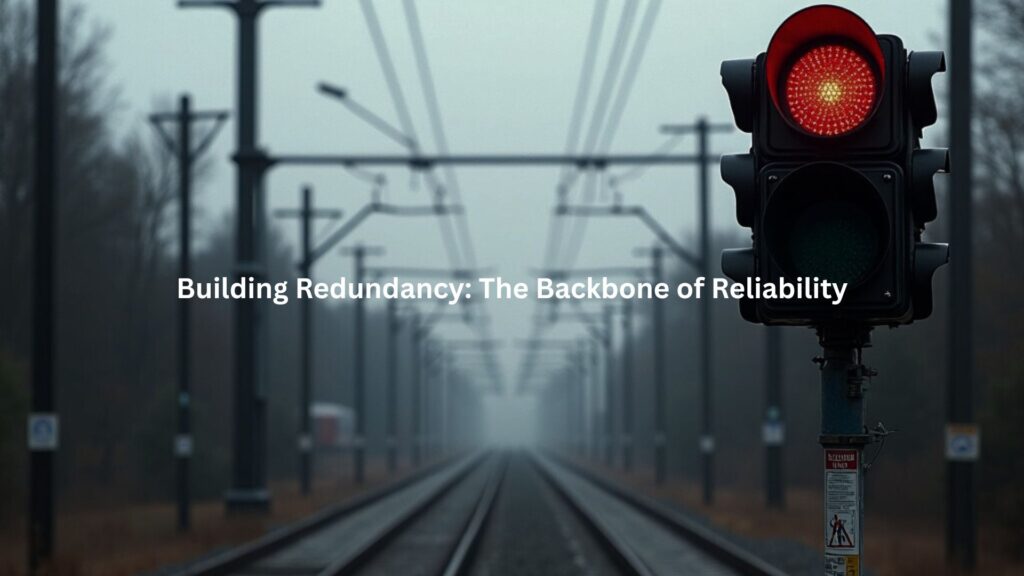
Every machine breaks – that’s just physics. A veteran engineer once told me watching a system fail is like seeing dominoes fall in slow motion. Through our years working with nuclear plants and defense networks, we’ve seen how small errors can snowball fast. Building fail-safes isn’t about preventing failures – it’s about containing them.
Think of a nuclear reactor’s control rods dropping automatically when coolant pressure drops, or how data centers switch to backup power before the main supply even fails completely. Operators call these “engineered safeguards,” but really they’re just common sense built into steel and code. Want to learn how different industries handle this? Keep reading.
Key Takeaways
- Break it before someone else does – that’s why failure analysis exists
- Layer your defenses deep – because one backup isn’t enough when things go south
- Smart alerts, fail-safe defaults, and solid contingency plans keep the wheels turning. And you need both automated and human eyes on deck
Identifying Failure Points: The First Step Toward Safety
Nobody likes to think about failure, but that’s exactly where we begin. Our team spends weeks mapping out every possible breaking point, every single one. We’ve learned this the hard way after seeing perfectly good systems fall apart from blind spots nobody caught early on. Take nuclear plants (scary stuff) – we make sure the system knows exactly when to hit the brakes if things get too hot.
Here’s what needs checking:
- Safety hazards that could shut everything down
- Weak spots in both hardware and code
- Places where humans might mess up (because we do, a lot)
Finding these weak points isn’t optional – it’s like fixing a ship. You wouldn’t set sail without knowing where the leaks might spring up, right? Keep reading to see how this all comes together.
Building Redundancy: The Backbone of Reliability

Here’s something we learned from countless sleepless nights fixing network outages – backup systems aren’t optional. Just last month, our team watched a major data center survive a power failure because we’d insisted on dual power supplies.
That’s redundancy in action. Aircraft designers get this too – they’ve got hydraulic backups ready when the main controls act up. And yeah, we’ve seen what happens when backups aren’t there (spoiler: nothing good).[1]
The trick is getting the balance right. Too few backups? The system’s vulnerable. Too many? Now you’re juggling complexity that might bite back. Some clients push back on the cost, but we’ve seen the alternative – complete system failure because somebody thought one backup was enough.
Basic stuff that needs doubling up:
- Hardware components (especially the ones that like to fail)
- Different ways to talk between systems
- Backup software that’s ready to jump in
Graceful Degradation: Keeping the Core Alive
Nobody wants their system to roll over and die when things go wrong. That’s where graceful degradation comes in – it’s about staying alive even when you’re taking hits. Power grids do this right – they’ll cut off overloaded sections while keeping critical areas running. Our security systems work the same way – if one defense layer fails, others pick up the slack.
We tell clients it’s like running on a sprained ankle – you slow down, but you don’t collapse. When our monitoring catches issues, the system automatically shuffles resources to keep essential operations going. Smart grid operators learned this lesson years ago – better to have partial service than none at all.
Critical points we always check:
- Resource allocation (what needs power first?)
- Warning systems that actually make sense
- Ways to avoid complete shutdowns
Safe Defaults: Designing for the Worst
Things break – that’s just physics. After watching countless systems fail over the years, our team learned to plan for the absolute worst. That’s why we always build around secure defaults fail-safe design, ensuring that when power dies or access fails, the system shuts down safely.
The alternative? Overheating and thousands in damage. Railroad folks figured this out decades ago – when signals lose power, everything stops. No power means no movement, period.
Safety trumps convenience every time. Our security protocols kick everyone out when authentication fails – yeah, it’s annoying, but better than letting the wrong person in. Some clients push back, wanting easier access, but we’ve seen too many breaches from “convenient” defaults.
Critical rules we never break:
- Systems must fail safely without power
- Lock everything down when in doubt
- Never trust “it probably won’t happen”
Detecting Failures Fast and Reacting Faster
Split-second decisions make all the difference. Last month, our monitoring caught a breach attempt three seconds faster than usual – saved a whole data center from lockdown.
These days, systems need to spot trouble and react before humans even notice something’s wrong. Part of that is avoiding insecure default settings that could leave gaps open long enough for attackers or failures to slip through.
We’ve built detection systems that watch everything:
- System health (the basics)
- Performance patterns (the weird stuff)
- Error rates (the scary stuff)
Getting alerts fast means fixing things fast. Sometimes that means automatic shutdowns – better to kill one process than lose the whole system.
Fallbacks and Retry Strategies: Keeping Services Running
Networks hiccup. Servers crash. Cloud services sometimes vanish. That’s life in tech. Smart systems don’t just die when this happens – they adapt. Our backup protocols switch to local cached data when cloud connections drop. Users barely notice because everything keeps working, just a bit slower.
The trick is knowing when to retry and when to wait. Hammering a failed service with retries just makes things worse. Instead, we space out retry attempts – wait a bit, try again, wait longer, try again. It’s like calling a busy phone line – constant redialing just jams things up more.
Key points from the field:
- Always have a Plan B (and C)
- Don’t make things worse by panicking
- Keep users running, even if it’s not perfect
Testing, Validation, and Human Integration
Credit: Tom Olzak
Designing fail-safe mechanisms isn’t complete without rigorous testing and human oversight. We simulate failure scenarios, sometimes using hardware-in-the-loop tests that mirror real-world conditions. Stress testing under various loads ensures robustness.
Humans remain critical. Some decisions need judgment beyond automated responses. Training operators on fail-safe protocols and integrating them into monitoring loops enhances system resilience.
- Test often, under diverse conditions.
- Validate fail-safe functions perform as expected.
- Keep humans involved for complex or ambiguous situations.
Following secure by default principles makes sure these safeguards are built into the system from the ground up. Fail-safe design is a human-machine partnership, not a solo act.
Real-World Examples Across Industries

A hospital ventilator has a backup battery that turns on if the power goes out, so the machine keeps helping patients breathe. Train signals are built the same way, when power fails, the lights drop to red, stopping trains before they can crash. In busy factories, robot arms freeze the moment a safety sensor spots danger.
These designs may look different, but they all share one rule: when things break, the system protects people first.
- In cars, brakes have a safety helper called ABS. If the wheels lock up on the road, ABS quickly steps in. It pumps the brakes fast so the tires keep gripping, and that can stop a skid before it turns into a crash.[2]
- Elevators engage emergency brakes if cable tension drops, protecting passengers.
- Smart grid circuits isolate overloads to avoid blackouts.
Every industry faces its own dangers, so each one uses fail-safe design in a way that fits. But the main goal never changes: keep people safe and keep the most important work going.
Conclusion
Safety isn’t some checkbox – it’s a mindset that shapes everything we build. After watching a power station’s backup system save thousands from blackout last summer, our team knows this firsthand.
From hospital gear to traffic controls, the rules don’t change: plan for the worst, build in backups, and make sure things fail safely. Twenty years in the field taught us that good engineering means accepting that things break. Want to build something that lasts? Start by planning how it’ll fail. Join the Secure Coding Practices Bootcamp
FAQ
How does fail-safe design improve system reliability in safety-critical systems?
Fail-safe design improves system reliability by using fail-safe mechanisms that activate during component failure. In safety-critical systems, engineers add redundancy systems, fault tolerance, and safety protocols to keep things working even when parts break. These fail-safe principles let machines move into a safe state or switch to backup systems when trouble starts. With risk assessment and failure mode analysis, weak spots are found early. By combining fail-safe operations with passive safety features, hazard mitigation becomes stronger. This approach builds system resilience and keeps failures from turning into disasters.
What role do redundancy engineering and fault detection play in fail-safe controls?
Redundancy engineering gives machines backup paths, while fault detection spots errors before they spread. Together they strengthen fail-safe controls. Fail-safe architecture often uses fault isolation, graceful degradation, and fallback mode to maintain function. Safety engineering adds fault detection algorithms and predictive maintenance tools. Emergency shutdown features and fail-safe circuits then stop unsafe events. With fail-safe testing and failure prevention, systems stay safer. That’s why fail-safe safety nets, fault-tolerant systems, and fallback procedures are key in building reliable and resilient operations.
How do fail-safe devices and fail-safe software support hazard mitigation in complex systems?
A fail-safe device often works with fail-safe software to make hazard mitigation more effective. Both connect to fail-safe architecture and fail-safe hardware, keeping safe defaults when problems appear. Safety-critical systems rely on fail-safe automation, fail-safe sensors, and fail-safe switch designs to react quickly. A fail-fast strategy, combined with fallback procedures, helps systems recover faster. Fail-safe communication and fail-safe monitoring add early warnings. In fail-safe operations, engineers depend on fail-safe alerting and fail-safe recovery to maintain a safe state. These fail-safe controls reduce risks and strengthen failure prevention.
Why are emergency shutdown systems and fail-safe safety nets important for system resilience?
Emergency shutdown systems serve as the final defense when fault detection signals danger. Fail-safe safety nets and fail-safe controls ensure even mechanical fail-safe and electromechanical fail-safe parts return to safe defaults. Backup systems, along with redundancy systems and fail-safe design patterns, add strength to system resilience. Engineers also use fail-safe inspection, fail-safe operational safety, and fail-safe recovery to handle emergencies. With fault isolation and fail-safe failover, systems can achieve graceful degradation. Fail-safe standards guide testing and failure mode analysis, supporting hazard mitigation and risk management at every stage.
How do fail-safe standards compliance and fail-safe engineering design guide system validation?
Fail-safe standards compliance sets rules for how safety-critical systems should respond under stress. Fail-safe engineering design applies these rules through fail-safe system validation and fail-safe system testing. Engineers check fail-safe integration, fail-safe safety margins, and fail-safe process design to confirm reliability. Predictive maintenance and fault detection algorithms improve failure prevention. Fail-safe design optimization and fail-safe design requirements refine systems for safety protocols and fallback procedures. Using fail-safe automation, fault-tolerant software, and fault-tolerant design, engineers create safe defaults that stand strong against risk management challenges.
References
- https://en.wikipedia.org/wiki/Core_damage_frequency
- https://en.wikipedia.org/wiki/Anti-lock_braking_system

